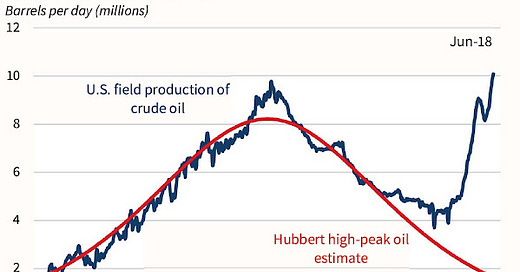The Most Amazing Graph of the 21st Century: How the Empire is Striking Back!

In 1956, Marion King Hubbert predicted that the US oil production would follow a "bell-shaped" curve, starting an irreversible decline around 1970. He was basically correct but, around 2010, the production curve restarted growing. This abrupt rebound was an amazing event that propelled the US back to the role of largest world producer of crude oil, and to become noticeably more bullish in geopolitical terms. Buoyed by its large oil production, the Empire is striking back. But for how long? (image by Paul Kedrosky)
Years ago, James Schlesinger noted that human beings have only two operational modes: complacency and panic. It is an observation that rings true and that we can generalize in terms of groups: some humans are catastrophists, and some are cornucopians. I tend to side with the catastrophists, to the point that I created the term "Seneca Effect" or "Seneca Cliff" to define the rapid decline that comes after that growth stops. Indeed, catastrophes are a common occurrence in human history, but it is also true that sometimes (rarely) a catastrophic decline can be reversed: I termed this effect the "Seneca Rebound."

There is an impressive example of rebound with the story of the US oil production. You probably know how, in 1956, Marion King Hubbert proposed his idea of the "bell-shaped" curve. He turned out to be approximately right in his prediction: the US oil production started to decline after peaking in 1970, following a trajectory that seemed to be irreversible. In the early 2000s, after nearly 40 years of decline, no geologist sane in his/her mind would have said that the decline could be stopped, to say nothing about reversing it. It was not a question of being catastrophist or cornucopian: the members of both categories would normally agree that extracting large amounts of oil from "non-conventional" sources was simply unthinkable in economic terms.
And then, something happened that changed everything. It took a few years before the new trend was clear but, by the mid-2010s, it couldn't be ignored anymore. By 2018, the US production had returned to the levels of its 1970 peak. In 2019, it had overcome it, and it kept growing. The production of natural gas followed the same trend, shooting up rapidly to levels never seen before. In 2020, the Covid crisis caused a new drop in production, at present only partially recovered. But let's forget the Covid story for now. What happened that changed things so much in the US oil industry?
You probably know that the cause has a name and a story: it is called tight oil or "shale oil," extracted by "fracking". It itself, it is nothing especially new, the concept was already known in the 1930s. The idea is to use high pressure to fracture the rock that contains the oil. That makes it possible for the liquid to flow to the surface. The problem with fracking is that it is expensive. So much that it is commonly said that nobody made any money on it. In 2017, an analysis by the Wall Street Journal arrived at the conclusion that, since 2007, “energy companies have spent $280 billion more than they generated from operations on shale investments.” Other analysts expressed the same concepts: you can extract oil from shales, but don't expect to make any money out of it. So, why are people insisting on pouring good money into bad wells?
There are good reasons. The people who discounted the possibility of extracting tight oil were perfectly able to evaluate the economic convenience of the process, but they didn't consider that the "market" is an abstraction that doesn't always work, actually, almost never works. So, those financial entities that provide money for oil exploration are part of a mix of interests that include the oil industry, the aerospace industry, the military industry, and others. This mix is what keeps the US economy alive. But there would be no aerospace or military industries if the oil industry could not produce enough oil.
It is impossible to say how the decision to pour immense amounts of money into tight oil was taken. Maybe it was a strategic decision taken by the military lobby in the US government (you may also note something curious: why was the US the only country that invested in shale oil extraction? After all, there are shale oil deposits in many other countries. I can think of an explanation, but I leave it to commenters to harp on conspiracy theories.) Or maybe the financial lobby recognized that they could survive losses in their investments in oil if these investments kept other sectors of the economy able to generate profits. Or, perhaps, it was a collective decision created by the great panic of 2008, when oil prices spiked up to 150 dollars per barrel. That event scared everyone enough to convince some of the key players that investing in oil was a good idea. In any case, with the second decade of the 21st century, the world changed.

The image above is by Michael Roscoe. It is not updated to the latest levels of oil production, but it shows how the US dominated the oil market (and the world), up to the 1960s. For a while, it was challenged by Russia and Saudi Arabia, but now the US is taking the lead again. Like all complex systems, the American Empire depended on the inflow of energy from the outside. So, it's not surprising that the Empire is striking back!

One of the visible consequences of the return of the Empire is that it abandoned Afghanistan, which it had invaded 20 years ago in search of new oil resources in Central Asia. These resources turned out to be elusive, perhaps not existing, but the US stubbornly insisted on staying in the area. Then, with tight oil, the powers that be realized that the US didn't need those resources anymore. And that they could concentrate on juicier targets, moving aggressively to push its main competitor, Russia, out of the European gas market. The US is also behaving aggressively toward China, which it correctly considers its main long-term competitor. Whether this will lead to a war, is all to be seen. But it is energy that makes wars possible.
But for how long will the shale bonanza last? As always, the future is obscure, but not completely. Shale oil remains a limited resource, no matter how often we hear that it will give us centuries of prosperity, or even that technology made it unlimited. After the Covid tsunami, shale oil production restarted to grow, but it has not yet reached the level it had in 2019. Also, its growth is clearly slowing down, while the Empire is facing new constraints in terms of overexploited resources: land, water, food, fertile soil, and more.

Is tight oil going to peak again and, this time, forever? We cannot say. We can only say that the American Empire is following the ebb and flow of the resources that make it exist. Such is the power of energy, and empires are but slaves to the forces that govern the universe!




